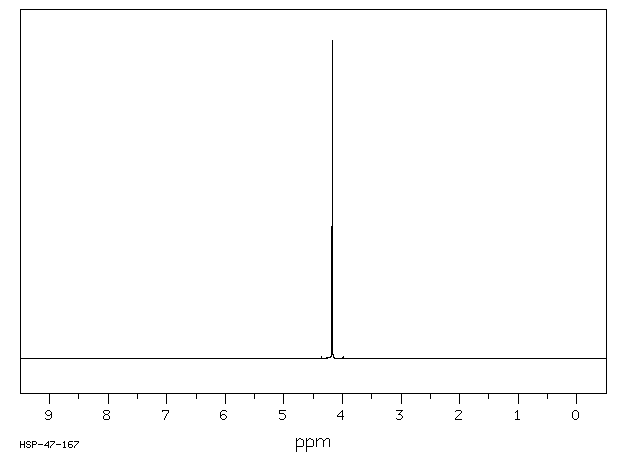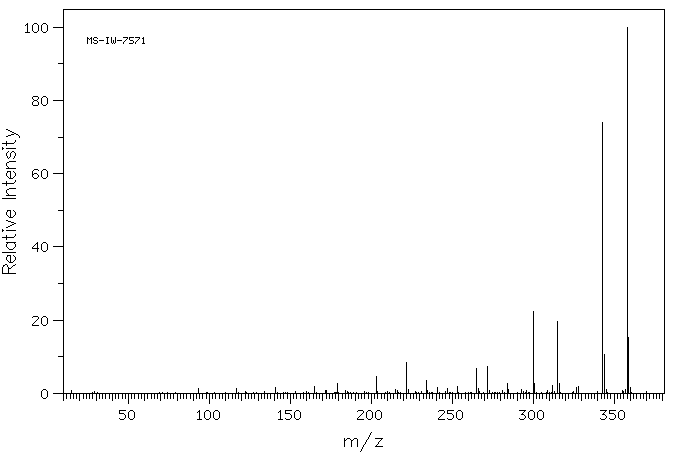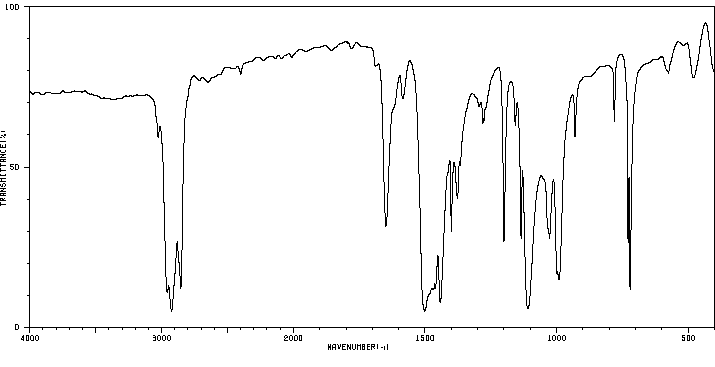4,4'-二甲氧基八氟联苯 | 2200-71-7
中文名称
4,4'-二甲氧基八氟联苯
中文别名
4,4-二甲氧基八氟联苯
英文名称
4,4'-Dimethoxy-octafluor-biphenyl
英文别名
4,4'-Dimethoxyoctafluorobiphenyl;1,2,4,5-tetrafluoro-3-methoxy-6-(2,3,5,6-tetrafluoro-4-methoxyphenyl)benzene
CAS
2200-71-7
化学式
C14H6F8O2
mdl
MFCD00039802
分子量
358.188
InChiKey
TVUPJKALGKCABC-UHFFFAOYSA-N
BEILSTEIN
——
EINECS
——
-
物化性质
-
计算性质
-
ADMET
-
安全信息
-
SDS
-
制备方法与用途
-
上下游信息
-
文献信息
-
表征谱图
-
同类化合物
-
相关功能分类
-
相关结构分类
物化性质
-
熔点:86-88 °C(lit.)
-
沸点:281℃
-
密度:1.515
-
闪点:131℃
-
溶解度:DMF:30mg/mL;二甲基亚砜:20mg/mL;乙醇:30mg/mL;乙醇:PBS (pH 7.2)(1:2): 0.3 mg/mL
计算性质
-
辛醇/水分配系数(LogP):4.3
-
重原子数:24
-
可旋转键数:3
-
环数:2.0
-
sp3杂化的碳原子比例:0.142
-
拓扑面积:18.5
-
氢给体数:0
-
氢受体数:10
安全信息
-
危险品标志:Xi
-
危险类别码:R36/37/38
-
危险品运输编号:UN 3152 9/PG 2
-
WGK Germany:3
-
海关编码:2909309090
-
安全说明:S26,S37/39
-
储存条件:室温
SDS
4,4'-二甲氧基八氟联苯 修改号码:2
模块 1. 化学品
产品名称: 4,4'-Dimethoxyoctafluorobiphenyl
修改号码: 2
模块 2. 危险性概述
GHS分类
物理性危害 未分类
健康危害
皮肤腐蚀/刺激 第2级
严重损伤/刺激眼睛 2A类
环境危害 未分类
GHS标签元素
图标或危害标志
信号词 警告
危险描述 造成皮肤刺激
造成严重眼刺激
防范说明
[预防] 处理后要彻底清洗双手。
穿戴防护手套/护目镜/防护面具。
[急救措施] 眼睛接触:用水小心清洗几分钟。如果方便,易操作,摘除隐形眼镜。继续冲洗。
眼睛接触:求医/就诊
皮肤接触:用大量肥皂和水轻轻洗。
若皮肤刺激:求医/就诊。
脱掉被污染的衣物,清洗后方可重新使用。
模块 3. 成分/组成信息
单一物质/混和物 单一物质
化学名(中文名): 4,4'-二甲氧基八氟联苯
百分比: >98.0%(GC)
CAS编码: 2200-71-7
俗名: Octafluoro-4,4'-dimethoxybiphenyl
分子式: C14H6F8O2
4,4'-二甲氧基八氟联苯 修改号码:2
模块 4. 急救措施
吸入: 将受害者移到新鲜空气处,保持呼吸通畅,休息。若感不适请求医/就诊。
皮肤接触: 立即去除/脱掉所有被污染的衣物。用大量肥皂和水轻轻洗。
若皮肤刺激或发生皮疹:求医/就诊。
眼睛接触: 用水小心清洗几分钟。如果方便,易操作,摘除隐形眼镜。继续清洗。
如果眼睛刺激:求医/就诊。
食入: 若感不适,求医/就诊。漱口。
紧急救助者的防护: 救援者需要穿戴个人防护用品,比如橡胶手套和气密性护目镜。
模块 5. 消防措施
合适的灭火剂: 干粉,泡沫,雾状水,二氧化碳
特殊危险性: 小心,燃烧或高温下可能分解产生毒烟。
特定方法: 从上风处灭火,根据周围环境选择合适的灭火方法。
非相关人员应该撤离至安全地方。
周围一旦着火:如果安全,移去可移动容器。
消防员的特殊防护用具: 灭火时,一定要穿戴个人防护用品。
模块 6. 泄漏应急处理
个人防护措施,防护用具, 使用个人防护用品。远离溢出物/泄露处并处在上风处。
紧急措施: 泄露区应该用安全带等圈起来,控制非相关人员进入。
环保措施: 防止进入下水道。
控制和清洗的方法和材料: 清扫收集粉尘,封入密闭容器。注意切勿分散。附着物或收集物应该立即根据合适的
法律法规处置。
模块 7. 操作处置与储存
处理
技术措施: 在通风良好处进行处理。穿戴合适的防护用具。防止粉尘扩散。处理后彻底清洗双手
和脸。
注意事项: 如果粉尘或浮质产生,使用局部排气。
操作处置注意事项: 避免接触皮肤、眼睛和衣物。
贮存
储存条件: 保持容器密闭。存放于凉爽、阴暗处。
远离不相容的材料比如氧化剂存放。
包装材料: 依据法律。
模块 8. 接触控制和个体防护
工程控制: 尽可能安装封闭体系或局部排风系统,操作人员切勿直接接触。同时安装淋浴器和洗
眼器。
个人防护用品
呼吸系统防护: 防尘面具。依据当地和政府法规。
手部防护: 防护手套。
眼睛防护: 安全防护镜。如果情况需要,佩戴面具。
皮肤和身体防护: 防护服。如果情况需要,穿戴防护靴。
模块 9. 理化特性
固体
外形(20°C):
外观: 晶体-粉末
颜色: 白色-极淡的黄色
气味: 无资料
4,4'-二甲氧基八氟联苯 修改号码:2
模块 9. 理化特性
pH: 无数据资料
熔点:
87°C
沸点/沸程 无资料
闪点: 无资料
爆炸特性
爆炸下限: 无资料
爆炸上限: 无资料
密度: 无资料
溶解度: 无资料
模块 10. 稳定性和反应性
稳定性: 一般情况下稳定。
反应性: 未报道特殊反应性。
须避免接触的物质 氧化剂
危险的分解产物: 一氧化碳, 二氧化碳, 氟化氢
模块 11. 毒理学信息
急性毒性: 无资料
对皮肤腐蚀或刺激: 无资料
对眼睛严重损害或刺激: 无资料
生殖细胞变异原性: 无资料
致癌性:
IARC = 无资料
NTP = 无资料
生殖毒性: 无资料
模块 12. 生态学信息
生态毒性:
鱼类: 无资料
甲壳类: 无资料
藻类: 无资料
残留性 / 降解性: 无资料
潜在生物累积 (BCF): 无资料
土壤中移动性
log水分配系数: 无资料
土壤吸收系数 (Koc): 无资料
亨利定律 无资料
constaNT(PaM3/mol):
模块 13. 废弃处置
如果可能,回收处理。请咨询当地管理部门。建议在可燃溶剂中溶解混合,在装有后燃和洗涤装置的化学焚烧炉中
焚烧。废弃处置时请遵守国家、地区和当地的所有法规。
模块 14. 运输信息
联合国分类: 与联合国分类标准不一致
UN编号: 未列明
模块 15. 法规信息
《危险化学品安全管理条例》(2002年1月26日国务院发布): 针对危险化学品的安全使用、生产、储存、运输、装
卸等方面均作了相应的规定。
4,4'-二甲氧基八氟联苯 修改号码:2
模块16 - 其他信息
N/A
模块 1. 化学品
产品名称: 4,4'-Dimethoxyoctafluorobiphenyl
修改号码: 2
模块 2. 危险性概述
GHS分类
物理性危害 未分类
健康危害
皮肤腐蚀/刺激 第2级
严重损伤/刺激眼睛 2A类
环境危害 未分类
GHS标签元素
图标或危害标志
信号词 警告
危险描述 造成皮肤刺激
造成严重眼刺激
防范说明
[预防] 处理后要彻底清洗双手。
穿戴防护手套/护目镜/防护面具。
[急救措施] 眼睛接触:用水小心清洗几分钟。如果方便,易操作,摘除隐形眼镜。继续冲洗。
眼睛接触:求医/就诊
皮肤接触:用大量肥皂和水轻轻洗。
若皮肤刺激:求医/就诊。
脱掉被污染的衣物,清洗后方可重新使用。
模块 3. 成分/组成信息
单一物质/混和物 单一物质
化学名(中文名): 4,4'-二甲氧基八氟联苯
百分比: >98.0%(GC)
CAS编码: 2200-71-7
俗名: Octafluoro-4,4'-dimethoxybiphenyl
分子式: C14H6F8O2
4,4'-二甲氧基八氟联苯 修改号码:2
模块 4. 急救措施
吸入: 将受害者移到新鲜空气处,保持呼吸通畅,休息。若感不适请求医/就诊。
皮肤接触: 立即去除/脱掉所有被污染的衣物。用大量肥皂和水轻轻洗。
若皮肤刺激或发生皮疹:求医/就诊。
眼睛接触: 用水小心清洗几分钟。如果方便,易操作,摘除隐形眼镜。继续清洗。
如果眼睛刺激:求医/就诊。
食入: 若感不适,求医/就诊。漱口。
紧急救助者的防护: 救援者需要穿戴个人防护用品,比如橡胶手套和气密性护目镜。
模块 5. 消防措施
合适的灭火剂: 干粉,泡沫,雾状水,二氧化碳
特殊危险性: 小心,燃烧或高温下可能分解产生毒烟。
特定方法: 从上风处灭火,根据周围环境选择合适的灭火方法。
非相关人员应该撤离至安全地方。
周围一旦着火:如果安全,移去可移动容器。
消防员的特殊防护用具: 灭火时,一定要穿戴个人防护用品。
模块 6. 泄漏应急处理
个人防护措施,防护用具, 使用个人防护用品。远离溢出物/泄露处并处在上风处。
紧急措施: 泄露区应该用安全带等圈起来,控制非相关人员进入。
环保措施: 防止进入下水道。
控制和清洗的方法和材料: 清扫收集粉尘,封入密闭容器。注意切勿分散。附着物或收集物应该立即根据合适的
法律法规处置。
模块 7. 操作处置与储存
处理
技术措施: 在通风良好处进行处理。穿戴合适的防护用具。防止粉尘扩散。处理后彻底清洗双手
和脸。
注意事项: 如果粉尘或浮质产生,使用局部排气。
操作处置注意事项: 避免接触皮肤、眼睛和衣物。
贮存
储存条件: 保持容器密闭。存放于凉爽、阴暗处。
远离不相容的材料比如氧化剂存放。
包装材料: 依据法律。
模块 8. 接触控制和个体防护
工程控制: 尽可能安装封闭体系或局部排风系统,操作人员切勿直接接触。同时安装淋浴器和洗
眼器。
个人防护用品
呼吸系统防护: 防尘面具。依据当地和政府法规。
手部防护: 防护手套。
眼睛防护: 安全防护镜。如果情况需要,佩戴面具。
皮肤和身体防护: 防护服。如果情况需要,穿戴防护靴。
模块 9. 理化特性
固体
外形(20°C):
外观: 晶体-粉末
颜色: 白色-极淡的黄色
气味: 无资料
4,4'-二甲氧基八氟联苯 修改号码:2
模块 9. 理化特性
pH: 无数据资料
熔点:
87°C
沸点/沸程 无资料
闪点: 无资料
爆炸特性
爆炸下限: 无资料
爆炸上限: 无资料
密度: 无资料
溶解度: 无资料
模块 10. 稳定性和反应性
稳定性: 一般情况下稳定。
反应性: 未报道特殊反应性。
须避免接触的物质 氧化剂
危险的分解产物: 一氧化碳, 二氧化碳, 氟化氢
模块 11. 毒理学信息
急性毒性: 无资料
对皮肤腐蚀或刺激: 无资料
对眼睛严重损害或刺激: 无资料
生殖细胞变异原性: 无资料
致癌性:
IARC = 无资料
NTP = 无资料
生殖毒性: 无资料
模块 12. 生态学信息
生态毒性:
鱼类: 无资料
甲壳类: 无资料
藻类: 无资料
残留性 / 降解性: 无资料
潜在生物累积 (BCF): 无资料
土壤中移动性
log水分配系数: 无资料
土壤吸收系数 (Koc): 无资料
亨利定律 无资料
constaNT(PaM3/mol):
模块 13. 废弃处置
如果可能,回收处理。请咨询当地管理部门。建议在可燃溶剂中溶解混合,在装有后燃和洗涤装置的化学焚烧炉中
焚烧。废弃处置时请遵守国家、地区和当地的所有法规。
模块 14. 运输信息
联合国分类: 与联合国分类标准不一致
UN编号: 未列明
模块 15. 法规信息
《危险化学品安全管理条例》(2002年1月26日国务院发布): 针对危险化学品的安全使用、生产、储存、运输、装
卸等方面均作了相应的规定。
4,4'-二甲氧基八氟联苯 修改号码:2
模块16 - 其他信息
N/A
上下游信息
-
上游原料
中文名称 英文名称 CAS号 化学式 分子量 十氟联苯 decafluorobiphenyl 434-90-2 C12F10 334.116 -
下游产品
中文名称 英文名称 CAS号 化学式 分子量 八氟-4,4'-联苯酚 2,2',3,3',5,5',6,6'-octafluoro-[1,1'-biphenyl]-4,4'-diol 2200-70-6 C12H2F8O2 330.134
反应信息
-
作为反应物:描述:参考文献:名称:CN114671762摘要:公开号:
-
作为产物:描述:2,3,5,6-四氟茴香醚 在 copper dichloride 氧气 、 lithium tert-butoxide 作用下, 以 N,N-二甲基甲酰胺 为溶剂, 反应 1.0h, 以64%的产率得到4,4'-二甲氧基八氟联苯参考文献:名称:COPPER-CATALYZED C-H BOND ARYLATION摘要:本发明是一种一步法,通过使用芳基卤化物、底物和铜盐作为催化剂,高效地将碳氢键转化为碳碳键的方法。该方法允许更快地引入复杂的分子实体,否则这个过程需要更多步骤。该发明特别适用于有机合成中复杂分子的合成,例如药用分子和爆炸物等。公开号:US20090076266A1
文献信息
-
Copper-Catalyzed Direct C–H Alkylation of Polyfluoroarenes by Using Hydrocarbons as an Alkylating Source作者:Weilong Xie、Joon Heo、Dongwook Kim、Sukbok ChangDOI:10.1021/jacs.0c00169日期:2020.4.22Construction of carbon-carbon bonds is one of the most important tools in chemical synthesis. In the previously established cross-coupling reactions, prefunctionalized starting materials are employed usually in the form of aryl- or alkyl (pseudo)halides or their metallated derivatives. However, direct use of arenes and alkanes via a twofold oxidative C-H bond activation strategy to access chemoselective C(sp2)-C(sp3)碳-碳键的构建是化学合成中最重要的工具之一。在先前建立的交叉偶联反应中,预官能化的起始材料通常以芳基或烷基(伪)卤化物或其金属化衍生物的形式使用。然而,由于碳氢 (CH) 键的低反应性和难度,通过双重氧化 CH 键活化策略直接使用芳烃和烷烃来获得化学选择性 C(sp2)-C(sp3) 交叉偶联非常具有挑战性。抑制副反应,如同源偶联。在此,我们介绍了在温和条件下铜催化多氟芳烃与烷烃的交叉脱氢偶联的新进展。新开发的催化剂体系不仅可以将相对较弱的 sp3 CH 键位于苄基或烯丙基位置,而且还可以将未活化的碳氢化合物烷基化。在包括气态原料和复杂分子在内的烷烃中的各种 CH 键中观察到中等至高位点选择性。通过结合实验和计算研究获得了机理信息,以揭示铜催化剂在激活烷烃的 sp3 CH 键和 sp2 多氟芳烃 CH 键方面起着双重作用。还提出非共价 π-π 相互作用和在最佳配体和芳烃底物之间原位形成的弱
-
A General Method for Copper-Catalyzed Arene Cross-Dimerization作者:Hien-Quang Do、Olafs DaugulisDOI:10.1021/ja2047717日期:2011.8.31A general method for a highly regioselective copper-catalyzed cross-coupling of two aromatic compounds using iodine as an oxidant has been developed. The reactions involve an initial iodination of one arene followed by arylation of the most acidic C-H bond of the other coupling component. Cross-coupling of electron-rich arenes, electron-poor arenes, and five- and six-membered heterocycles is possible
-
Constructing a Catalytic Cycle for C–F to C–X (X = O, S, N) Bond Transformation Based on Gold-Mediated Ligand Nucleophilic Attack作者:Ji-Yun Hu、Jing Zhang、Gao-Xiang Wang、Hao-Ling Sun、Jun-Long ZhangDOI:10.1021/acs.inorgchem.5b02634日期:2016.3.7replacement of Cl by a more nucleophilic tBuO anion ligand, showed higher reactivity and para selectivity in the transformation of C–F to C–OtBu bond, distinctively different from that when only KOtBu was used (ortho selectivity) under the identical condition. Mechanistic studies including density functional theory calculations suggested a gold-mediated nucleophilic ligand attack of the C–F bond pathway三配位氯化金(I)络合物tBuXantphosAuCl,由空间庞大的9,9-二甲基-4,5-双(二叔丁基)支撑合成了丁基丁基膦基)的蒽酮配体(tBuXantphos)。该络合物的特征是与双配位线性金络合物(2.27–2.30Å)和三配位XantphosAuCl [2.462(1)Å]相比,Au–Cl键长[2.632(1)Å]长得多。tBuXantphosAuCl和五氟硝基苯(PFNB)的共晶体的单晶X射线衍射分析和紫外可见分光光度法滴定实验表明,Cl阴离子配体与PFNB之间存在阴离子-π相互作用。PFNB与tBuXantphosAuOtBu之间的化学计量反应在被更具亲核性的tBuO阴离子配体取代Cl后,在C–F向C–OtBu键的转化中表现出更高的反应性和对位选择性,这与仅使用KOtBu时显着不同(邻位选择性) )在相同的条件下。N Ar工艺。根据这些结果,使用三甲基甲硅烷基衍生物TMS-X(X
-
Polyfluorophenyl acetylenes and related compounds作者:Ian Barrow、Alan E. PedlerDOI:10.1016/0040-4020(76)85181-2日期:1976.1corresponding 3-(polyfluorophenyl) prop-2-ynol derivative. Where R = N(CH3)2- and NH2- the acetylenic alcohol was not obtained; these were synthesized by the reaction of dimethylamine and ammonia with 3-(pentafluorophenyl)prop2-ynol itself. The acetylenic alcohols were converted to the corresponding polyfluorophenyl acetylenes by nickel peroxide in dioxan/aqueous NaOH. With benzene at 60° as solvent 3-(pent
-
Process for making polyesters申请人:Wu Hengpeng公开号:US20050234201A1公开(公告)日:2005-10-20The present invention relates to a process for making a polyester where a dianhydride is reacted with a diol. The resulting polyester can be further reacted with a compound selected from aromatic oxides, aliphatic oxides, alkylene carbonates, alcohols, and mixtures thereof.本发明涉及一种制造聚酯的工艺,其中二酸酐与二元醇发生反应。生成的聚酯可进一步与选自芳香族氧化物、脂肪族氧化物、碳酸亚烷基酯、醇及其混合物的化合物反应。
表征谱图
-
氢谱1HNMR
-
质谱MS
-
碳谱13CNMR
-
红外IR
-
拉曼Raman
-
峰位数据
-
峰位匹配
-
表征信息
同类化合物
(βS)-β-氨基-4-(4-羟基苯氧基)-3,5-二碘苯甲丙醇
(S,S)-邻甲苯基-DIPAMP
(S)-(-)-7'-〔4(S)-(苄基)恶唑-2-基]-7-二(3,5-二-叔丁基苯基)膦基-2,2',3,3'-四氢-1,1-螺二氢茚
(S)-盐酸沙丁胺醇
(S)-3-(叔丁基)-4-(2,6-二甲氧基苯基)-2,3-二氢苯并[d][1,3]氧磷杂环戊二烯
(S)-2,2'-双[双(3,5-三氟甲基苯基)膦基]-4,4',6,6'-四甲氧基联苯
(S)-1-[3,5-双(三氟甲基)苯基]-3-[1-(二甲基氨基)-3-甲基丁烷-2-基]硫脲
(R)富马酸托特罗定
(R)-(-)-盐酸尼古地平
(R)-(-)-4,12-双(二苯基膦基)[2.2]对环芳烷(1,5环辛二烯)铑(I)四氟硼酸盐
(R)-(+)-7-双(3,5-二叔丁基苯基)膦基7''-[((6-甲基吡啶-2-基甲基)氨基]-2,2'',3,3''-四氢-1,1''-螺双茚满
(R)-(+)-7-双(3,5-二叔丁基苯基)膦基7''-[(4-叔丁基吡啶-2-基甲基)氨基]-2,2'',3,3''-四氢-1,1''-螺双茚满
(R)-(+)-7-双(3,5-二叔丁基苯基)膦基7''-[(3-甲基吡啶-2-基甲基)氨基]-2,2'',3,3''-四氢-1,1''-螺双茚满
(R)-(+)-4,7-双(3,5-二-叔丁基苯基)膦基-7“-[(吡啶-2-基甲基)氨基]-2,2”,3,3'-四氢1,1'-螺二茚满
(R)-3-(叔丁基)-4-(2,6-二苯氧基苯基)-2,3-二氢苯并[d][1,3]氧杂磷杂环戊烯
(R)-2-[((二苯基膦基)甲基]吡咯烷
(R)-1-[3,5-双(三氟甲基)苯基]-3-[1-(二甲基氨基)-3-甲基丁烷-2-基]硫脲
(N-(4-甲氧基苯基)-N-甲基-3-(1-哌啶基)丙-2-烯酰胺)
(5-溴-2-羟基苯基)-4-氯苯甲酮
(5-溴-2-氯苯基)(4-羟基苯基)甲酮
(5-氧代-3-苯基-2,5-二氢-1,2,3,4-oxatriazol-3-鎓)
(4S,5R)-4-甲基-5-苯基-1,2,3-氧代噻唑烷-2,2-二氧化物-3-羧酸叔丁酯
(4S,4''S)-2,2''-亚环戊基双[4,5-二氢-4-(苯甲基)恶唑]
(4-溴苯基)-[2-氟-4-[6-[甲基(丙-2-烯基)氨基]己氧基]苯基]甲酮
(4-丁氧基苯甲基)三苯基溴化磷
(3aR,8aR)-(-)-4,4,8,8-四(3,5-二甲基苯基)四氢-2,2-二甲基-6-苯基-1,3-二氧戊环[4,5-e]二恶唑磷
(3aR,6aS)-5-氧代六氢环戊基[c]吡咯-2(1H)-羧酸酯
(2Z)-3-[[(4-氯苯基)氨基]-2-氰基丙烯酸乙酯
(2S,3S,5S)-5-(叔丁氧基甲酰氨基)-2-(N-5-噻唑基-甲氧羰基)氨基-1,6-二苯基-3-羟基己烷
(2S,2''S,3S,3''S)-3,3''-二叔丁基-4,4''-双(2,6-二甲氧基苯基)-2,2'',3,3''-四氢-2,2''-联苯并[d][1,3]氧杂磷杂戊环
(2S)-(-)-2-{[[[[3,5-双(氟代甲基)苯基]氨基]硫代甲基]氨基}-N-(二苯基甲基)-N,3,3-三甲基丁酰胺
(2S)-2-[[[[[((1S,2S)-2-氨基环己基]氨基]硫代甲基]氨基]-N-(二苯甲基)-N,3,3-三甲基丁酰胺
(2S)-2-[[[[[[((1R,2R)-2-氨基环己基]氨基]硫代甲基]氨基]-N-(二苯甲基)-N,3,3-三甲基丁酰胺
(2-硝基苯基)磷酸三酰胺
(2,6-二氯苯基)乙酰氯
(2,3-二甲氧基-5-甲基苯基)硼酸
(1S,2S,3S,5S)-5-叠氮基-3-(苯基甲氧基)-2-[(苯基甲氧基)甲基]环戊醇
(1S,2S,3R,5R)-2-(苄氧基)甲基-6-氧杂双环[3.1.0]己-3-醇
(1-(4-氟苯基)环丙基)甲胺盐酸盐
(1-(3-溴苯基)环丁基)甲胺盐酸盐
(1-(2-氯苯基)环丁基)甲胺盐酸盐
(1-(2-氟苯基)环丙基)甲胺盐酸盐
(1-(2,6-二氟苯基)环丙基)甲胺盐酸盐
(-)-去甲基西布曲明
龙蒿油
龙胆酸钠
龙胆酸叔丁酯
龙胆酸
龙胆紫-d6
龙胆紫









